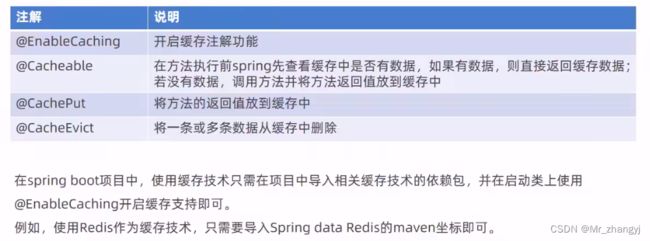瑞吉外卖 —— 11、项目优化:使用 Redis 缓存
目录
1、问题说明
2、环境搭建
2.1、导入依赖
2.2、配置文件
2.3、配置类
3、缓存短信验证码
3.1、实现思路
3.2、代码
3.2.1、发送验证码时将验证码缓存到Redis
3.2.1、登录
4、缓存菜品数据
4.1、实现思路
4.2、代码
4.2.1、list 方法
4.2.2、update 方法
4.2.3、save 方法
5、Spring Cache
5.1、Spring Cache 介绍
5.2、常用注解
5.3、基本使用
5.3.1、依赖
5.3.2、@CachePut
5.3.3、@CacheEvict
5.3.4、Cacheable
5.4、以 Redis 作为缓存
5.4.1、依赖
5.4.2、application.yml 配置
6、缓存套餐数据
6.1、实现思路
6.2、代码
6.2.1、导入依赖
6.2.2、设置缓存数据过期时间
6.2.3、开启缓存,加上 @EnableCaching 注解
6.2.4、R 类序列化
6.2.5、list 方法
6.2.6、delete 和 save 方法
1、问题说明
方法:通过缓存进行优化
2、环境搭建
2.1、导入依赖
在 pom.xml 中导入依赖
org.springframework.boot
spring-boot-starter-data-redis
2.2、配置文件
在 application.yml 中添加配置
注意,这里由于使用 host、port、password 报错 ERR wrong number of arguments for ‘auth‘ command,所以改为使用 url 进行配置
详情查看:ERR wrong number of arguments for ‘auth‘ command_lisen_123a的博客-CSDN博客
spring:
redis:
# host: 192.168.44.128
# port: 6379
username: root
# password: ***
url: redis://@: 2.3、配置类
import org.springframework.cache.annotation.CachingConfigurerSupport;
import org.springframework.context.annotation.Bean;
import org.springframework.context.annotation.Configuration;
import org.springframework.data.redis.connection.RedisConnectionFactory;
import org.springframework.data.redis.core.RedisTemplate;
import org.springframework.data.redis.serializer.StringRedisSerializer;
/**
* Redis配置类
* @Author zhang
* @Date 2022/9/12 - 15:02
* @Version 1.0
*/
@Configuration
public class RedisConfig extends CachingConfigurerSupport {
@Bean
public RedisTemplate redisTemplate(RedisConnectionFactory connectionFactory) {
RedisTemplate redisTemplate = new RedisTemplate<>();
//默认的Key序列化器为:JdkSerializationRedisSerializer
redisTemplate.setKeySerializer(new StringRedisSerializer());
redisTemplate.setHashKeySerializer(new StringRedisSerializer());
redisTemplate.setConnectionFactory(connectionFactory);
return redisTemplate;
}
} 3、缓存短信验证码
3.1、实现思路
3.2、代码
3.2.1、发送验证码时将验证码缓存到Redis
/**
* 发送手机验证码
* @param user
* @return
*/
@PostMapping("/sendMsg")
public R sendMsg(@RequestBody User user, HttpSession session) throws ExecutionException, InterruptedException {
// 获取手机号
String phone = user.getPhone();
if(StringUtils.isNotEmpty(phone)) {
// 生成随机的4为验证码
String code = ValidateCodeUtils.generateValidateCode(4).toString();
log.info("code={}", code);
// 调用阿里云提供的短信服务API完成发送短信
//SMSUtils.sendMessage(phone, code);
// 将验证码存储到Session中
//session.setAttribute(phone, code);
// 将验证码缓存到Redis,有效期为5分钟
redisTemplate.opsForValue().set(phone, code, 5, TimeUnit.MINUTES);
return R.success("手机验证码发送成功");
}
return R.error("短信发送失败");
} 3.2.1、登录
/**
* 移动端用户登录
* @param map
* @param session
* @return
*/
@PostMapping("/login")
public R login(@RequestBody Map map, HttpSession session){
// 获取手机号、验证码
String phone = map.get("phone").toString();
String code = map.get("code").toString();
// 从session获取保存的验证码
//Object codeInSession = session.getAttribute(phone);
// 从Redis获取缓存的验证码
Object codeInSession = redisTemplate.opsForValue().get(phone);
// 验证码比对
if(codeInSession != null && codeInSession.equals(code)){
// 比对成功,登录成功
// 判断当前手机号对应的用户是否为新用户,若是则自动完成注册
LambdaQueryWrapper queryWrapper = new LambdaQueryWrapper<>();
queryWrapper.eq(User::getPhone, phone);
User user = userService.getOne(queryWrapper);
if(user == null){
user = new User();
user.setPhone(phone);
user.setStatus(1);
userService.save(user);
}
session.setAttribute("user", user.getId());
// 登录成功,删除Redis中缓存的验证码
redisTemplate.delete(phone)l;
return R.success(user);
}
return R.error("验证码错误,请重新输入");
} 4、缓存菜品数据
4.1、实现思路
这里删除的方法也要请缓存
4.2、代码
4.2.1、list 方法
@GetMapping("/list")
public R> list(Dish dish){
List dishDtoList = null;
// 动态构造key
String key = "dish_" + dish.getCategoryId() + "_" + dish.getStatus();
// 从redis中获取缓存数据
dishDtoList = (List) redisTemplate.opsForValue().get(key);
if(dishDtoList != null) {
// 若存在,直接返回,无需查询数据库
return R.success(dishDtoList);
}
// 若不存在,查询数据库,将查询到的菜品缓存到redis
LambdaQueryWrapper queryWrapper = new LambdaQueryWrapper<>();
queryWrapper.eq(dish.getCategoryId() != null, Dish::getCategoryId, dish.getCategoryId());
queryWrapper.eq(Dish::getStatus, 1);
queryWrapper.orderByAsc(Dish::getSort).orderByDesc(Dish::getUpdateTime);
List list = dishSerivce.list(queryWrapper);
dishDtoList = list.stream().map((item) -> {
DishDto dishDto = new DishDto();
BeanUtils.copyProperties(item, dishDto);
// 获取分类名称
Long categoryId = item.getCategoryId();
Category category = categoryService.getById(categoryId);
if(category != null){
String categoryName = category.getName();
dishDto.setCategoryName(categoryName);
}
// 获取口味信息
Long dishId = item.getId();
LambdaQueryWrapper wrapper = new LambdaQueryWrapper<>();
wrapper.eq(DishFlavor::getDishId, dishId);
List dishFlavorList = dishFlavorService.list(wrapper);
dishDto.setFlavors(dishFlavorList);
return dishDto;
}).collect(Collectors.toList());
redisTemplate.opsForValue().set(key, dishDtoList, 60, TimeUnit.MINUTES);
return R.success(dishDtoList);
} 4.2.2、update 方法
/**
* 修改菜品
* @return
*/
@PutMapping
public R update(@RequestBody DishDto dishDto){
dishSerivce.updateWithFlavor(dishDto);
// 清理所有菜品的缓存数据
Set keys = redisTemplate.keys("dish_*");
redisTemplate.delete(keys);
return R.success("修改菜品成功");
} 4.2.3、save 方法
/**
* 新增菜品
* @param dishDto
* @return
*/
@PostMapping
public R save(@RequestBody DishDto dishDto){
//log.info(dishDto.toString());
dishSerivce.saveWithFlavor(dishDto);
// 清理修改的菜品的缓存数据
String key = "dish_" + dishDto.getCategoryId() + "_1";
redisTemplate.delete(key);
return R.success("新增菜品成功");
} 5、Spring Cache
5.1、Spring Cache 介绍
5.2、常用注解
5.3、基本使用
5.3.1、依赖
Spring Cache 的依赖在 spring-boot-starter-web 中
org.springframework.boot
spring-boot-starter-web
compile
5.3.2、@CachePut
/**
* CachePut:将方法返回值放入缓存
* value:缓存的名称,每个缓存下可以有多个key
* key:缓存的key
* @param user
* @return
*/
@CachePut(value = "userCache", key = "#user.id")
@PostMapping
public User save(User user){
userService.save(user);
return user;
}5.3.3、@CacheEvict
/**
* CacheEvict:清理指定缓存,key有多种写法
* @param id
*/
@CacheEvict(value = "userCache", key = "#id")
//@CacheEvict(value = "userCache", key = "#root.args[0]")
//@CacheEvict(value = "userCache", key = "#p0")
@DeleteMapping("/{id}")
public void delete(@PathVariable Long id){
userService.removeById(id);
}
@CacheEvict(value = "userCache", key = "#p0.id")
//@CacheEvict(value = "userCache", key = "#root.args[0].id")
//@CacheEvict(value = "userCache", key = "#user.id")
//@CacheEvict(value = "userCache", key = "#result.id")
@PutMapping
public User update(User user){
userService.updateById(user);
return user;
}5.3.4、Cacheable
/**
* Cacheable:在方法执行前spring先查看缓存中是否有数据,如果有数据,则直接返回缓存数据;若没有数据,调用方法并将方法返回值放到缓存中
* 若数据库没有找到数据,以null为key
* condition:缓存条件,满足条件才缓存
* @param id
* @return
*/
@Cacheable(value = "userCache", key = "#id", unless = "#result == null")
@GetMapping("/{id}")
public User getById(@PathVariable Long id){
User user = userService.getById(id);
return user;
}5.4、以 Redis 作为缓存
5.4.1、依赖
org.springframework.boot
spring-boot-starter-cache
org.springframework.boot
spring-boot-starter-data-redis
主要使用
![]()
5.4.2、application.yml 配置
spring:
redis:
host: 192.168.44.128
port: 6379
password: root
database: 0
cache:
redis:
time-to-live: 1800000 # 设置缓存有效时间,以毫秒为单位6、缓存套餐数据
6.1、实现思路
6.2、代码
6.2.1、导入依赖
org.springframework.boot
spring-boot-starter-data-redis
org.springframework.boot
spring-boot-starter-cache
6.2.2、设置缓存数据过期时间
spring:
cache:
redis:
time-to-live: 1800000 # 设置缓存有效时间,以毫秒为单位6.2.3、开启缓存,加上 @EnableCaching 注解
@EnableCaching // 开启Spring Cache缓存6.2.4、R 类序列化
public class R implements Serializable 6.2.5、list 方法
/**
* 根据条件获取套餐数据
* @param setmeal
* @return
*/
@GetMapping("/list")
@Cacheable(value = "setmealCache", key = "#setmeal.categoryId + '_' + #setmeal.status")
public R> list(Setmeal setmeal){
LambdaQueryWrapper queryWrapper = new LambdaQueryWrapper<>();
queryWrapper.eq(setmeal.getCategoryId() != null, Setmeal::getCategoryId, setmeal.getCategoryId());
queryWrapper.eq(setmeal.getStatus() != null, Setmeal::getStatus, setmeal.getStatus());
queryWrapper.orderByDesc(Setmeal::getUpdateTime);
List list = setmealService.list(queryWrapper);
return R.success(list);
} 6.2.6、delete 和 save 方法
/**
* 批量删除套餐
* allEntries:清理value分类下所有缓存数据
* @param ids
* @return
*/
@DeleteMapping
@CacheEvict(value = "setmealCache", allEntries = true)
public R delete(@RequestParam List ids){
setmealService.removeWithDish(ids);
return R.success("套餐数据删除成功");
}
/**
* 新增套餐
* allEntries:清理value分类下所有缓存数据
* @param setmealDto
* @return
*/
@PostMapping
@CacheEvict(value = "setmealCache", allEntries = true)
public R save(@RequestBody SetmealDto setmealDto){
setmealService.saveWithDish(setmealDto);
return R.success("新增套餐成功");
} 




